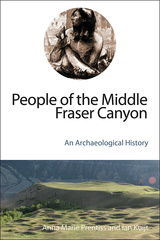A Complex Culture of the British Columbia Plateau
Traditional Stl'atl'imx Resource Use
Early hunter/gatherer societies have traditionally been considered basically egalitarian in nature. This assumption, however, has been challenged by contemporary archaeological and anthropological research, which has demonstrated that many of these societies had complex social, economic, and political structures.
This volume considers two British Columbia Native communities – the Lillooet and Shuswap communities of Fountain and Pavilion – and traces their development into complex societies. The authors explore the relation between resource characteristics and hunter/gatherer adaptations and examine the use of fish, animal, and plant species, documenting their availability and the techniques used in their gathering, processing, and storing. The book also shows how cultural practices, such as raiding, potlatching, and stewardship of resources, can be explained from a cultural ecological point of view. An important contribution to the study of hunting and gathering cultures in the Northwest, this book is the most detailed examination of the subsistence base of a particular hunting and gathering group to date. Its exploration of the reasons why complex hunting and gathering societies emerge, as well as the ecological relationships between cultures and resources, will make an important contribution to the study of cultural ecology and contemporary archaeology.
This volume gathers together a variety of investigations that were subsidiary to the main archaeological work, work primarily concerned with aspects of ethnographic use of this environment by the Lillooet ...This will be an important volume for my library, and one that may gain importance when the main research findings, those deriving from the Keatly Creek site itself, reach print.
A book of vital importance for specialists in these areas, as well as for scholars interested in subsistence strategies among Native peoples in other parts of North America.
Hayden's chapters offer clear and extended discussions of his current views on cultural ecology, cultural materialism, and complex hunter-gatherers. All of the chapters are clear and well written. The volume will be a major source of comparative information for archaeologists and ethnographers for decades.
Figures, Plates, and Tables
Preface and Acknowledgments
1 Introduction: Ecology and Culture / Brian Hayden
2 Environmental Units / Diana Alexander
3 A Reconstruction of Prehistoric Land Use in the Mid-Fraser River Area Based on Ethnographic Data / Diana Alexander
4 Salmon Availability, Technology, and Cultural Adaptation in the Fraser River Watershed / Michael Kew
5 Fraser Lillooet Salmon Fishing / Steven Romanoff
6 Stl’atl’imx (Fraser River Lillooet) Fishing / Dorothy I.D. Kennedy and Randy Bouchard
7 Traditional and Contemporary Land and Resource Use by Ts'kw’aylaxw and Xaxli’p Bands / Robert Tyhurst
8 Plant Resources of the Stl’atl’imx (Fraser River Lillooet) People: A Window into the Past / Nancy J. Turner
9 The Cultural Ecology of Hunting and Potlatches Among the Lillooet Indians / Steven Romanoff
10 Conflict and Salmon on the Interior Plateau of British Columbia / Aubrey Cannon
11 Conclusions: Ecology and Complex Hunter/Gatherers / Brian Hayden
Index




